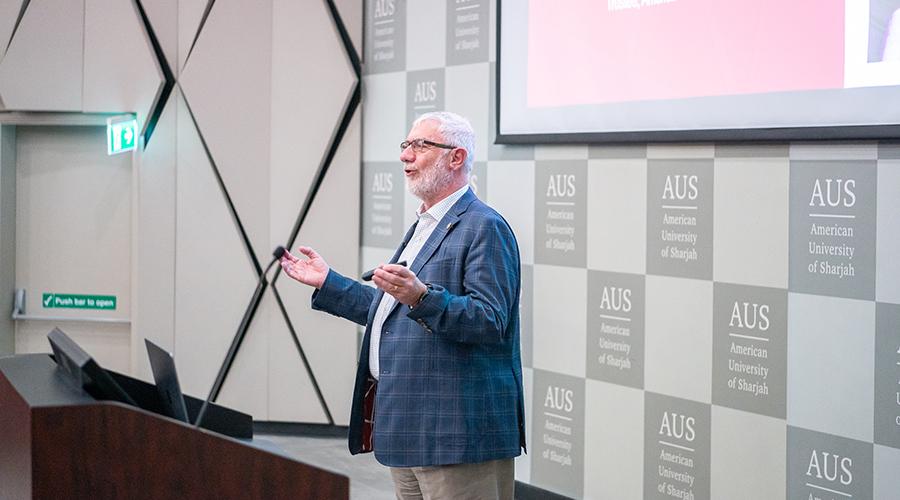- About
- Admissions
- Study at AUS
- Prospective Students
- Bachelor's Degrees
- Master's Degrees
- Doctoral Degrees
- Admission Publications
- International Students
- Contact Admissions
- Grants and Scholarships
- Sponsorship Liaison Services
- Testing Center
- New Undergraduate Student Guide
- New Graduate Student Guide
- File Completion
- New Student Orientation
- Payment Guide
- Executive Education
- Students with Disabilities
- Academics
- Life at AUS
- Research
- Publications
- Contact Us
- Apply Now
- .

AUS trustee and renowned mathematician discuss superoscillations and the revolutionization of European mathematics
Imagine talking on the phone with a friend, but instead of using your regular words, you are using a special language that lets you convey more information faster and more efficiently.
Let’s call this special language superoscillations.
This specialized mathematical term—used mostly in the fields of physics, engineering and mathematics—describes an oscillatory phenomena or wave patterns, where, in layman terms, a wave appears to be wiggling much faster than expected based on the overall frequency of the wave. This leads to making communication faster, images sharper, sounds clearer, products more durable and the internet faster. This is why its applications can be found in medical imaging, acoustics and ultrasounds, optics, material sciences and more.
Often described by scientists as an exciting field because it involves phenomena that defy conventional expectations, superoscillation was recently a subject of discussion in a workshop at American University of Sharjah (AUS) led by Dr. Daniele C. Struppa, President of Chapman University in the US and member of the AUS Board of Trustees. Organized by the College of Arts and Sciences (CAS) in collaboration with the Department of Mathematics and Statistics, the workshop brought together students, faculty and interested staff from various departments at AUS.
“Our speaker is a renowned mathematician and an international expert in the field of Fourier Analysis. This field of research holds significant importance in applied mathematics, particularly in its applications within the realms of physics and signal processing. Such workshops facilitate interdisciplinary collaboration and exchange of ideas. The workshop was meant to inspire exploration of new research avenues and contribute to the advancement of knowledge in the field of superoscillation,” said Dr. Abdul Salam Jarrah, Professor and Head of the Department of Mathematics and Statistics at AUS.
The department also hosted Dr. Struppa for a session where he discussed Leonardo Fibonacci’s role in the transmission of Arabic mathematics to Europe. Best known for introducing the Hindu-Arabic numeral system, including the use of the digit zero, to Europe, the Italian mathematician is said to have traveled in the Mediterranean and encountered the mathematical works of Arab scholars, who had expanded upon the mathematical knowledge of ancient Greece, India and Persia. It is argued that Fibonacci’s introduction of the Hindu-Arabic numeral system revolutionized European mathematics and commerce.
Dr. Struppa is the 13th President of Chapman University in Orange, California. Before assuming this title in 2016, he served as Chapman University’s Chancellor (Chief Academic Officer) for 10 years and as Dean of the College of Arts and Sciences at George Mason University for nine years. He is a mathematician whose expertise is in Fourier Analysis and has authored 10 volumes and more than 200 peer-reviewed publications and holds several patents in the field of signal processing. He is the recipient of numerous awards, including the 2016 Cozzarelli Prize from the National Academy of Sciences and the Ellis Island Medal of Honor, and is a member of the National Academy of Inventors.
To learn more about the Department of Mathematics and Statistics at AUS, visit www.aus.edu/cas/department-of-mathematics-and-statistics.

